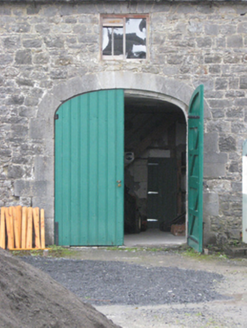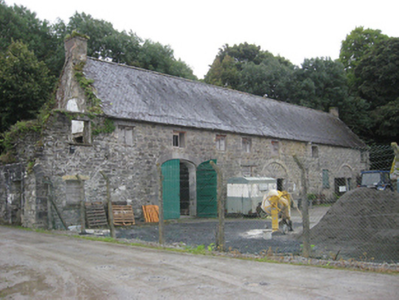Survey Data
Reg No
30343049
Rating
Regional
Categories of Special Interest
Archaeological, Architectural
Original Use
Farmyard complex
In Use As
Workshop
Date
1780 - 1820
Coordinates
185269, 204037
Date Recorded
08/09/2009
Date Updated
--/--/--
Description
Rectangular courtyard, built c.1800, with east side of rubble limestone bawn wall and circular flanking tower of c.1618 forming west side. Other walls of rubble limestone, with cut-stone copings to all sides. Tower to north-west corner has crenellations, rubble stone walls with corbelled cut-stone string course. Square-headed pedestrian entrance in north wall of courtyard with timber panelled door. Square-profile gate piers with mild steel gate to south wall. Two-bay single-storey outbuilding with pitched slate roof, snecked limestone walls and square-headed openings with timber doors to south. Single-storey outbuildings with pitched roof, rubble limestone and brick walls and square-headed openings to north. Mild steel gates to east. Detached seven-bay two-storey former coach house to south end of east wall is surviving south part of range of outbuildings. Pitched slate roofs with clay ridge riles, red brick and cement rendered chimneystacks and cast-iron rainwater goods. Dressed limestone walls having square-headed window openings with stone surrounds and timber fittings and remains of double-light timber casement windows, elliptical carriage arch with ashlar stone surround and timber double-leaf door to north end,and infilled segmental-headed carriage arches with brick and stone surrounds now containing square-headed openings with timber doors. Springing of south side of carriage throughway at north end of main outbuilding
Appraisal
Constructed as a service yard for Portumna Castle this functional structure was an integral part of the demesne and forms part of a group of demesne-related features including the formal gateways, avenue, gate lodges, icehouse and nearby stableyard. The fine two-storey outbuilding to the south-east side of the yard indicates something of the former appearance and quality of the other buildings. Its two-light windows echo those of the Castle, and the various arched carriage openings are of well worked limestone.



